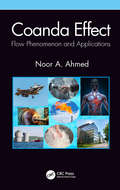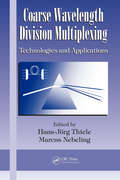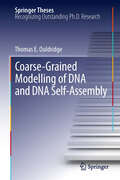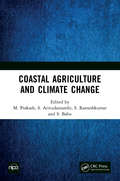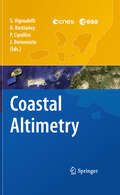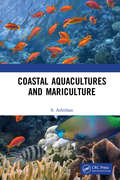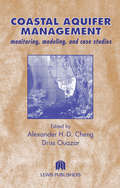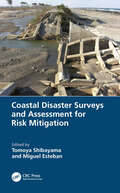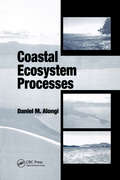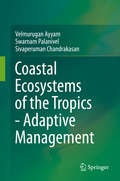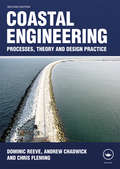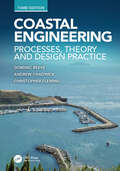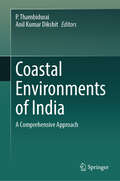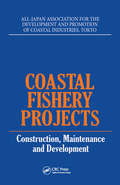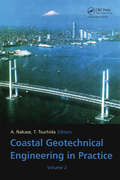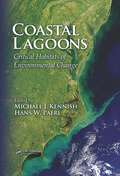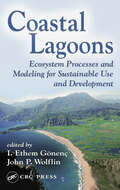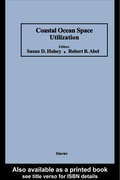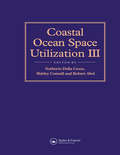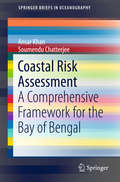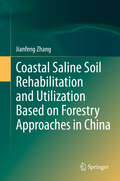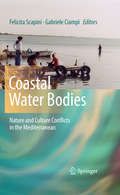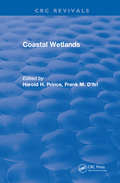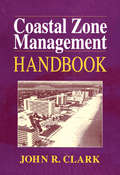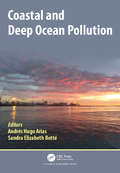- Table View
- List View
Coanda Effect: Flow Phenomenon and Applications
by Noor A AhmedCoanda effect is a complex fluid flow phenomenon enabling the production of vertical take-off/landing aircraft. Other applications range from helicopters to road vehicles, from flow mixing to combustion, from noise reduction to pollution control, from power generation to robot operation, and so forth. Book starts with description of the effect, its history and general formulation of governing equations/simplifications used in different applications. Further, it gives an account of this effect’s lift boosting potential on a wing and in non-flying vehicles including industrial applications. Finally, occurrence of the same in human body and associated adverse medical conditions are explained.
Coarse Wavelength Division Multiplexing: Technologies and Applications (Optical Science and Engineering)
by Hans-Jörg Thiele Marcus NebelingExplaining what CWDM is, how it is achieved, and why it should be deployed, Coarse Wavelength Division Multiplexing: Technologies and Applications merges coverage of isolated aspects of Coarse Wavelength Division Multiplexing (CWDM) traditionally found as device-related or specific system topics. Emphasizing cost savings and performance enhancement, the book integrates information on component issues, system architectures, concepts for extensions and upgrades, as well as practical applications into a comprehensive, single-volume resource. Beginning with a summary of the ITU-T standards defining CWDM, the book addresses the three essential component classes, optical fibers, transceivers, and WDM filters, which combine to form the basis for the CWDM transmission link. The following chapters include coverage of different architectures such as hubbed rings and meshed networks, and upgrade paths to overcome limitations of current CWDM systems. The book outlines the feasibility of optically amplified CWDM systems, investigates the challenges present with high-speed CWDM and bidirectional transmission, and finally elucidates the importance of CWDM for a wide range of applications. Each chapter provides sufficient information to be used independently and contains references to relevant papers and articles for further study. The last sections of the book focus on applications and case studies where CWDM plays an ever-increasing role. They include extensive studies on networking, reach extension by amplification, and the latest concepts of transmission capacity upgrades using increased bit-rates or new channel plans. Filled with practical information, the book provides a clear understanding of recent developments in the dynamic field of CWDM.
Coarse-Grained Modelling of DNA and DNA Self-Assembly (Springer Theses)
by Thomas E. OuldridgeThis thesis presents a novel coarse-grained model of DNA, in which bases are represented as rigid nucleotides. The model is shown to quantitatively reproduce many phenomena, including elastic properties of the double-stranded state, hairpin formation in single strands and hybridization of pairs of strands to form duplexes, the first time such a wide range of properties has been captured by a coarse-grained model. The scope and potential of the model is demonstrated by simulating DNA tweezers, an iconic nanodevice, and a two-footed DNA walker -- the first time that coarse-grained modelling has been applied to dynamic DNA nanotechnology.
Coastal Agriculture and Climate Change
by M. PrakashChanging climate in micro and macro level attribute to influence and bring changes in productivity and production trend of every industry including agriculture and its ecosystem. The influence of climate change and its environmental impact on coastal ecosystem greatly influence the life and livelihood of agrarian communities and people involved in allied industries. The book has been authored with objectives of providing understanding on the environmental problems, features of coastal ecosystem, advanced strategies for environmental protection, mitigation strategies for environmental problems in coastal areas and augmenting agriculture income from coastal areas.Note: T&F does not sell or distribute the hardback in India, Pakistan, Nepal, Bhutan, Bangladesh and Sri Lanka. This title is co-published with NIPA.
Coastal Altimetry
by Andrey G. Kostianoy Jérôme Benveniste Paolo Cipollini Stefano VignudelliThe book describes experience in application of coastal altimetry to different parts of the World Ocean. It presents the principal problems related to the altimetry derived products in coastal regions of the ocean and ways of their improvement. This publication is based on numerous satellite and observational data collected and analyzed by the authors of the various chapters in the framework of a set of international projects, performed in UK, France, Italy, Denmark, Russia, USA, Mexico and India. The book will contribute both to the ongoing International Altimeter Service effort and to the building of a sustained coastal observing system in the perspective of GMES (Global Monitoring for Environment and Security) and GEOSS (Global Earth Observation System of Systems) initiatives. This book is aimed at specialists concerned with research in the various fields of satellite altimetry, remote sensing, and coastal physical oceanography. The book will be also interesting for lecturers, students and post-graduate students.
Coastal Aquaculture and Mariculture
by S. AthithanThis book is an effort to consolidate and comprehensively present the coastal aquaculture & mariculture and divided into 39 chapters covering introduction, mariculture scenario, finfish farming, shellfish farming, molluscan farming, seaweed farming, recirculatory aquaculture systems, conservation aspects in mariculture etc. This is an attempt to provide comprehensive information on all areas of coastal aquaculture and mariculture to the students for their academic carrier. Nonetheless, the material presented has been thoughtfully selected and updated to make it of maximum use to the readers.Note: T& F does not sell or distribute the Hardback in India, Pakistan, Nepal, Bhutan, Bangladesh and Sri Lanka.
Coastal Aquifer Management-Monitoring, Modeling, and Case Studies
by Alexander H.-D. Cheng Driss OuazarApproximately 70% of the world's population lives in coastal areas, and the majority of these people depend on coastal aquifers for freshwater. The fragility of these aquifers and their sensitivity to human activity demand informed, competent management to guarantee their survival. Significant knowledge and new technologies related to the subject h
Coastal Disaster Surveys and Assessment for Risk Mitigation
by Miguel Esteban Tomoya ShibayamaThis collection covers essential concepts in the management of coastal disasters, outlining several field surveys of such events that have taken place in the 21st century, including the Indian Ocean Tsunami, the Tohoku Earthquake and Tsunami, and the storm surges generated by Hurricane Katrina, Cyclone Nargis, and Typhoon Haiyan. Measurements of flood heights, distributions of structural destruction, and the testimonies of residents are reported, with the results being analysed and compared with past events and numerical simulations to clarify and reconstruct the reality of these disasters. The book covers the state-of-the-art understanding of disaster mechanisms and the most advanced tools for the simulation of future events: • Uniquely explains how to use disaster surveys along with simulations to mitigate risk • Combines pure scientific studies with practical research and proposes procedures for effective coastal disaster mitigation Coastal Disaster Surveys and Assessment for Risk Mitigation is ideal for students in the field of disaster risk management, as well as engineers who deal with issues related to tsunamis, storm surges, high wave attack and coastal erosion.
Coastal Ecosystem Processes
by Daniel M. AlongiCoastal Ecosystem Processes, written by the renowned marine scientist Daniel Alongi, describes how pelagic and benthic food webs, from beaches and tidal flats to the continental edge, process energy and matter. This volume focuses on recent advances and new developments on how food webs are closely intertwined with the geology, chemistry, and physics of coastal seas. Dr. Alongi presents a process-functional approach as a way of understanding how the energetics of coastal ecosystems rely not only on exchanges within and between food chains, but how such functions are influenced by terrigenous and atmospheric processes. There is a need for documentation and an awareness of just how necessary, yet delicate, is the interplay of biological and physical forces between coastal ocean, land, and the atmosphere. Marine scientists today need to make informed management decisions about sustainable development and conservation of these fragile ecosystems. Coastal Ecosystem Processes provides present and future marine scientists the latest coastal ecosystem information to make the right decisions concerning the ecology of our oceans.
Coastal Ecosystems of the Tropics - Adaptive Management
by Velmurugan Ayyam Swarnam Palanivel Sivaperuman ChandrakasanThe coastal areas of the tropics are rich in biodiversity, natural resources and place of intensive developmental activities as it provides livelihood to millions of people. At the same time evidences suggest that several unique coastal ecosystems viz., mangroves, wetlands, salt marshes, corals, estuaries, sand dunes and agro-ecosystem are vulnerable to natural disasters and events associated with global climate change. In recent times degradation of land, water and genetic erosion besides threat to native flora and fauna have been increasing due to unsustainable developmental activities. Therefore, a paradigm shift in deriving livelihood through conventional methods, developmental strategies, conservation practices are required for balanced and sustainable growth of the coastal areas. This publication strives to cover the status of different natural resources of the coastal region, various aspects of degradation process, production need and restorative methods besides new technological options and its socio-economic implications with case examples. Special focus is given to bring out the scope and potential of mangrove based farming, integrated and organic farming and its value addition besides the role of coastal vegetations as bioshield in protecting these regions from sea erosion, cyclones and tsunami. As the tropical coastal areas are vulnerable to climate change events, this book also covers the recent weather pattern, impacts of climate change and climate resilient technologies besides intuitional linkages and policy framework aimed at balancing development and environmental concerns.
Coastal Engineering: Processes, Theory and Design Practice
by Andrew Chadwick Dominic Reeve Christopher FlemingHistorically, much harm has been done by well-meaning coastal engineering attempts, which seemed like good ideas on paper but which failed to allow for practical issues. For this reason, it is vital that theories and models are well grounded in practice. This second edition brings the models and examples of practice up to date. It has expanded coverage of tsunamis and generating energy from waves to focus both on the great dangers and the great opportunities that the ocean presents to the coastal zone. With an emphasis on practice and detailed modelling, this is a thorough introduction to all aspects of coastal processes, morphology, and design of coastal defences. It describes numerous case studies to illustrate the successful application of mathematical modelling to real-world practice. A must-have book for engineering students looking to specialize in coastal engineering and management.
Coastal Engineering: Processes, Theory and Design Practice
by Andrew Chadwick Dominic Reeve Christopher FlemingEffective coastal engineering is expensive, but it is not as costly as neglect or ineffective intervention. Good practice needs to be based on sound principles, but theoretical work and modelling also need to be well grounded in practice, which is continuously evolving. Conceptual and detailed design has been advanced by new industry publications since the publication of the second edition. This third edition provides a number of updates: the sections on wave overtopping have been updated to reflect changes brought in with the recently issued EurOtop II manual; a detailed worked example is given of the calculation of extreme wave conditions for design; additional examples have been included on the reliability of structures and probabilistic design; the method for tidal analysis and calculation of amplitudes and phases of harmonic constituents from water level time series has been introduced in a new appendix together with a worked example of harmonic analysis; and a real-life example is included of a design adapting to climate change. This book is especially useful as an information source for undergraduates and engineering MSc students specializing in coastal engineering and management. Readers require a good grounding in basic fluid mechanics or engineering hydraulics, and some familiarity with elementary statistical concepts.
Coastal Environments of India: A Comprehensive Approach
by Anil Kumar Dikshit P. ThambiduraiCoastal environments are unique and highly dynamic ecosystems that play a vital role in climate regulation, support biodiversity, and highly impact human activities. This book deals with a combination of specialized areas in multiple fields. It covers the coastal ecosystem of marine life and its importance for biodiversity conservation. Sincerely addressing significant coastal dynamics, including coastal erosion and sedimentation on the shorelines. Natural hazards that caused widespread damage all along the coastal habitation on a global scale. Further, it evaluates the effects of human activities on coastal development, pollution, and predation on marine ecosystems, besides adding notorious human-induced pollution, which is of great environmental concern now. Importantly, this combination of specializing within an area of multiple fields leads to a broad range of research issues. This book offers numerous components of study to create a comprehensive guide for future prospects.
Coastal Fishery Projects
by V. PanditA manual on the development and reconstruction of coastal fishing areas. Coverage ranges from design conditions, through use of tidal currents for sea water flow, to improvement of water quality and breeding facilities.
Coastal Geotechnical Engineering in Practice, Volume 2: Proceedings of the International Symposium IS-Yokohama 2000, Yokohama, Japan, 20-22 September 2000
by Takashi Tsuchida Akio NakaseThe International Symposium on "Coastal Geotechnical Engineering in Practice (IS-Yokohama 2000)" was held from 20 to 22 September 2000 in Yokohama, Japan and sponsored both by TC-30 of ISSMGE on "Coastal Geotechnical Engineering" and by the Japanese Geotechnical Society (JGS). This symposium attracted 310 participants from many countries and IS-Yokohama 2000 is remembered as a successful event for gathering valuable information and experiences from various researchers and case studies on soft ground engineering technology in coastal areas. During the symposium participants heard invited leading experts present lectures and reports and had a chance to meet with representatives of various research fields of interest. As a fulfilment of the promis made during the symposium, a second volume was produced after the conference with contributed paper of those presentations in keynote addresses, special lectures, project reports and special discussion sessions, with the hope that this will be a valuable reference for engineers, academics, consultants and those who are interested in Coastal Geotechnical Engineering.
Coastal Lagoons: Critical Habitats of Environmental Change (ISSN)
by Michael J. Kennish Hans W. PaerlWritten by an outstanding group of contributors, this book examines the function and structure of coastal lagoonal ecosystems and the natural and anthropogenic drivers of change that affect them, most notably nutrient over-enrichment from coastal watersheds and airsheds. The contributors target the susceptibility of coastal lagoons to eutrophication, the indicators of eutrophic conditions, the influences of natural factors such as major storms and other climate effects, and the resulting biotic and ecosystem impairments that have developed. The book compares biogeochemical and ecological response to nutrient enrichment and other pollutants in lagoonal estuaries to those in other estuarine types.
Coastal Lagoons: Ecosystem Processes and Modeling for Sustainable Use and Development
by John P. Wolflin I. Ethem GönençCoastal Lagoons: Ecosystem Processes and Modeling for Sustainable Use and Development describes the concepts, models, and data needed to design and implement management programs for long-term sustainability of coastal lagoons. Based on a project conducted under the auspices of NATO-CCMS, the book provides information and methodologies essential for
Coastal Ocean Space Utilization
by Susan D. Halsey Sandy Hook Robert B. AbelProceedings of the First International Symposium on Coastal Ocean Space Utilization (COSU 89), One World Trade Center, New York, 8-10 May 1989.
Coastal Ocean Space Utilization 3
by R.B. Abel S. Connell N. Della CroceArising out of The Third International Symposium held in New Jersey, this book represents the state-of-the-art in ocean management. From the Baltic to the Caribbean, from the Adriatic to the Atlantic, the problems of ocean management are fully discussed, and proposals made to meet the challenges of the next decade. This book will be of immense inte
Coastal Risk Assessment: A Comprehensive Framework For The Bay Of Bengal (Springerbriefs In Oceanography Ser.)
by Soumendu Chatterjee Ansar KhanThis book discusses how to collect data and analyze databases in order to map risk zones, and contributes to developing a conceptual framework for coastal risk assessment. Further, the book primarily focuses on a specific case study: the Bay of Bengal along the southeastern coast of India. The dramatic rise in losses and casualties due to natural disasters like wind, storm-surge-induced flooding, seismic hazards and tsunami incidence along this coast over the past few decades has prompted a major national scientific initiative investigating the probable causes and possible mitigation strategies. As such, geoscientists are called upon to analyze the coastal hazards by anticipating the changes in and impacts of extreme weather hazards on the Bay of Bengal coasts as a result of global climate change and local sea-level change.
Coastal Saline Soil Rehabilitation and Utilization Based on Forestry Approaches in China
by Jianfeng ZhangThe most recent advances in research on coastal saline soil rehabilitation and utilization based on forestry approach are discussed. The forestry approach is emphasized rather than physical or engineering measures to ameliorate saline soils, which is significant for coastal environmental improvement and land resources expansion. The monograph is a useful reference for researchers using techniques of ecology, forestry and agronomy. Prof. Jianfeng Zhang works at the Institute of Subtropical Forestry, Chinese Academy of Forestry. He has been working on afforestation in saline soils for over 20 years.
Coastal Water Bodies: Nature and Culture Conflicts in the Mediterranean
by Felicita Scapini Gabriele CiampiAddressing the links between science and the real world with a sound scientific baseline, Coastal Water Bodies targets researchers of various disciplines whose interest lies in the integrated sustainable management of coastal water bodies. The main topic of this book is not the ecology according to its accepted meaning, but rather the 'places and people' concerned - the coastal zones of the Mediterranean that are rich in ecological value and the local people who survive thanks to these environmental resources. Integration is the joint consideration of different aspects of water uses and values, and new ways of understanding and managing conflicts around water use are needed if people are to benefit from integration. Sustainability of the ecological and socioeconomic environments requires a climate in which conflicts, if they need to exist, are properly managed in a non-destructive manner.
Coastal Wetlands
by Harold H. PrinceThis book represents the proceedings of the firstGreat Lakes Costal Wetlands Colloquium (November 5-7, 1984; East Lansing, Michigan). The theme wasNatural and Manipulated Water Levels in Great Lakes Wetlands. This material constitutes both Great Lakes wetlands and the state of understanding about them. It is intended to provide fisheries and wildlife biologists, ecologists, aquatic resource managers and planners and environmental scientists information about the coastal wetlands in regard to eight priority areas. The colloquium and publication of the proceedings were cosponsored by Sea Grant Program and Environment Canada.
Coastal Zone Management Handbook
by John R. ClarkCoastal Zone Management Handbook comprises the first complete manual on coastal resource planning and management technology. Written by an international consultant, this handbook reflects a global perspective on the natural resources, sensitivities, economics, development, productivity, and diversity of coastal zones. The emphasis is on tropical and subtropical coastal ecosystems, but the information is widely applicable. In addition to its comprehensive coverage of general concepts related to coastal regions, the book describes the strategic basis for coastal management, provides a set of working tools for management and planning activities, and presents case histories of management projects around the globe. Extensive references are provided for each management analysis, practice, technique, and solution. Coastal Zone Management Handbook is made up of four sections:
Coastal and Deep Ocean Pollution
by Andrés Hugo Arias; Sandra Elizabeth BottéDuring the recent decades, social, political and academic endeavours have been made to improve environmental quality and reduce pollution. In particular, the ocean, sea and coastal areas show varying degrees of impact from the multiple human activities carried out in the terrestrial as well as in the aquatic environment. Ecology is a science which studies the relationship between organisms and the surrounding environment and in the modern era, the marine world is getting increasing attention. For centuries it has been the final reservoir of human garbage; later it became an oil farm with a concomitant increase of coastal population growth and unplanned growth of the fishing industry and the increasing use of sea routes for cargo transport and recreational uses (cruises). All this led to rising contamination with negative effects on biota and even human health. It is then imperative to know the current situation of the world's oceans: that is the main purpose of this book, to document at a glance the latest research in the field of ocean pollution.
